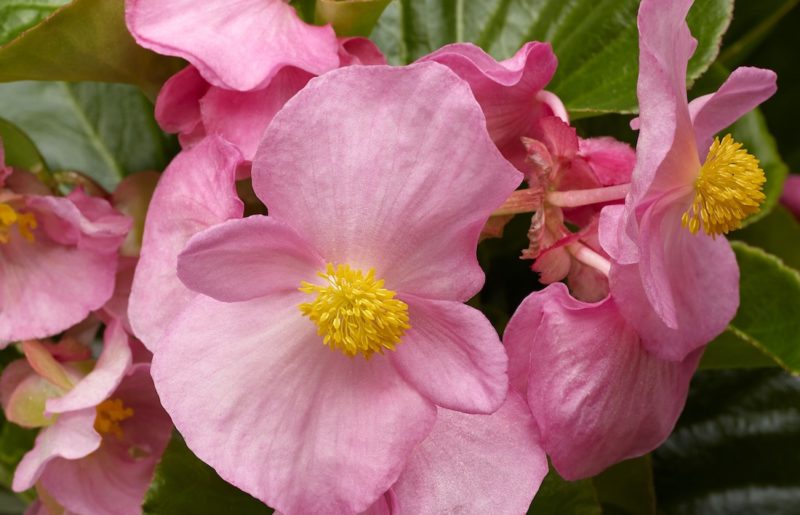
Culture Report: Begonia Top Hat Series
Tophat begonia is an exciting new introduction into the XL begonia class from Syngenta Flowers. It has many benefits to growers and consumers that set it apart from the competition.
Tophat has the only white flowered XL begonia on the market. It’s versatile and can be finished in many pot sizes including 306 packs. It also totes the largest flowers and fastest finish on the market. Tophat’s naturally branching habit gives it a rounded, mounding habit that is controlled and easy to ship. Flowers that cover the canopy at finish make it an outstanding gallon or 10-inch hanging basket crop. Tophat performs beautifully in the sun or shade and is great for in-ground or large containers growing to about 16 to 20 inches tall. All the colors match well together to make excellent tri-color combinations.
Here are some culture tips to produce the best quality Tophat begonia.
MOISTURE MANAGEMENT DURING PROPAGATION
Moisture management is key during begonia propagation, and Tophat is no exception. Consistent moisture management and careful irrigation early in the plug crop results in highly uniform begonia seedlings, whereas uneven moisture leads to non-uniform growth and losses.

Apply enough irrigation at the time of sow to adequately soften the seed pellet. Keep a consistent moisture level 4 until germination to keep the pellet from re-hardening and restricting germination. There are many benefits to pelleted seed like making seed easier to see and sow, but be sure to apply enough moisture to soften and eventually dissolve the pellet from your begonia seed.
Keep trays in the germination chamber at 72 to 78° F for six to nine days to help ensure more uniform germination. If you don’t have a germination chamber, use tenting or fabric covering over the trays for the first two to three weeks. After 21 days, true leaves should be expanding and covering can be removed.
Use a low water volume and very fine mist nozzles when irrigating plugs for the first three weeks. Too much water pressure or large droplet sizes will move the tiny seeds around and delay seedling establishment. When first true leaves are about the size of a pencil eraser, water droplet size and water volume can be increased. Use fogger nozzles for spot watering. Very fine cone nozzles should be used for irrigation booms.
GROWING A QUALITY PLUG

We recommend a 288-cell tray with one seed per cell for producing Tophat plugs. Light is not required for germination. Tophat begonia is day length neutral. HID lighting providing a higher daily light integral (DLI) will speed up germination and uniformity of seedlings. Plugs should finish in about six to nine weeks. Fertilization can be increased over the course of the plug crop from 75- to 125-ppm nitrogen; maintaining an electrical conductivity of 1.0 to 1.25 (saturated media extract) and a pH range of 5.4 to 5.8 is critical to healthy plug growth. A B-Nine (daminozide) spray a week before transplant may be desired to tone plugs.
FINISHING A TOP-NOTCH PLANT
Tophat is very versatile and can be finished in 306 packs up to 3-gallon baskets. For 306 packs to 2.5-quart containers, we recommend one plant per pot. For 3-quart pots to 3-gallon baskets, we recommend three plants per pot to get to the fastest fill time.
Finishing temperatures at an average daily temperature of 65 to 70° F is recommended. Pinching is not necessary.
Maintain moderate fertility at 150- to 200-ppm nitrogen for proper tone and growth performance.
Fungal pressures from low light and high humidity in the spring can be managed with proper air movement and broad spectrum fungicides labeled for begonias.
PLANT GROWTH REGULATION
Once plugs have established in the finish container, a PGR application of 2,500- to 5,000-ppm B-Nine spray is recommended to control stem elongation without reducing flower size. Bonzi (paclobutrazol) drenches at 0.25 ppm may also be used to control stem elongation and leaf size, but will reduce flower size by about 10 percent. Bonzi sprays will significantly reduce flower size. For example, a 10-ppm spray will reduce flower size by 20 percent and is not recommended. Cool finish temperatures and high DLI maximize flower size and help to control excessive leaf expansion.


 Video Library
Video Library 




















